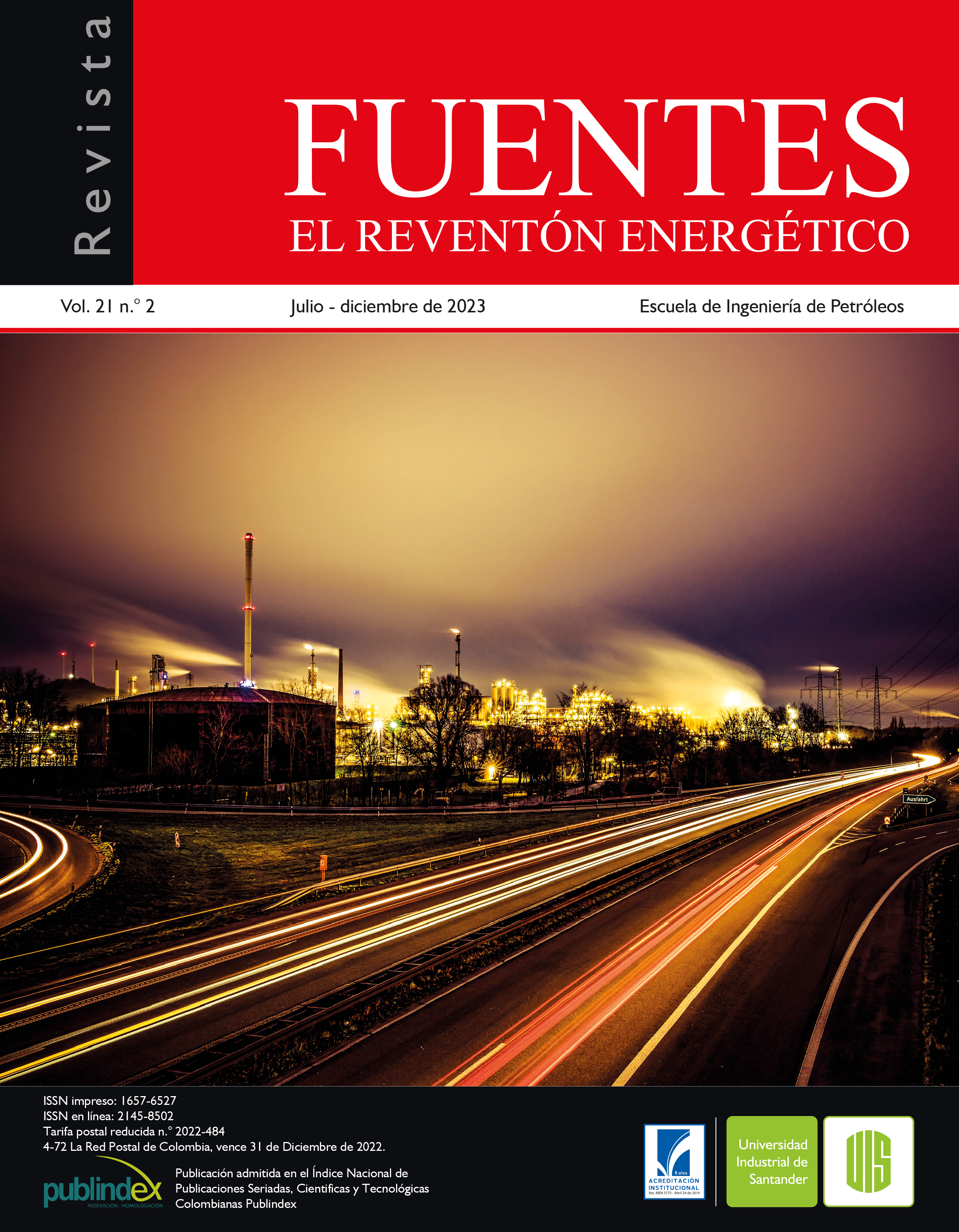CORRELACIÓN EXPERIMENTAL SOBRE LA INFLUENCIA DE LA COMPOSICIÓN Y LA TEMPERATURA EN LAS PROPIEDADES TERMOFÍSICAS DE LOS ACEROS PARA APLICACIONES DE INGENIERÍA
Publicado 2023-12-13
Palabras clave
- Propiedades Termofísicas,
- Método de Ajuste Progresivo,
- Generalización de Datos Experimentales,
- Error Medio Absoluto
Cómo citar

Esta obra está bajo una licencia internacional Creative Commons Atribución 4.0.
Resumen
En este trabajo es presentado un método predictivo para la estimar la variación de tres propiedades termofísicas (difusividad térmica, calor especifico y conductividad térmica) de 32 AISI-SAE clases comerciales de aceros laminados y recocidos, a una temperatura de trabajo desde 0 a 800oC y con una composición (C, Mn, S, P, Ni, Si, Mo, Cr, V). El método de ajuste de funciones es utilizado para el tratamiento y generalización de los datos experimentales disponibles, obteniéndose una ecuación que proporciona ajustes satisfactorios para extender su uso a la ingeniería térmica. Los modelos propuestos fueron verificados por comparación con datos experimentales disponibles. Para la difusividad térmica, calor especifico y conductividad térmica, los modelos obtenidos correlacionan con una desviación de , ±17.6 % y ±8.2 %, ±16.6 % respectivamente. El peor ajuste de correlación se corresponde a la difusividad térmica del acero AISI-SAE 316, con un error máximo de 17.6 % y un error medio absoluto (EMA) del 8.2 % en el 80.6% de los datos experimentales disponibles. El mejor ajuste lo proporciona el calor específico del acero AISI-SAE 1078, con un error máximo de 1.9 % y un EMA del 1.1% en el 68.3 % de las muestras experimentales disponibles. En todos los casos, el acuerdo del modelo propuesto con los datos experimentales disponibles es lo suficientemente bueno como para ser considerado satisfactorio para diseño práctico.
Descargas
Referencias
- Borisade, S.G., Ajibola, O.O., Adebayo, A.O., & Oyetunji, A. (2021). Development of mathematical models for the prediction of mechanical properties of low carbon steel (LCS). Materials Today: Proceedings, 38, 1133-1139. https://doi.org/10.1016/j.matpr.2020.07.134
- Bouissa, Y., Shahriari, D., Champliaud, H., & Jahazi, M. (2019). Prediction of heat transfer coefficient during quenching of large size forged blocks using modeling and experimental validation. Case Studies in Thermal Engineering, 13, 100379. https://doi.org/10.1016/j.csite.2018.100379
- Camaraza-Medina, Y. (2021) Methods for the determination of the heat transfer coefficient in air cooled condenser used at biomass power plants, International Journal of Heat and Technology, 39(5), 1443-1450.https://doi.org/10.18280/ijht.390505
- Camaraza-Medina, Y., Retirado-Mediaceja, Y., Hernandez-Guerrero, A., & Luviano-Ortiz, J.L. (2021). Energy efficiency indicators of the steam boiler in a power plant of Cuba. Thermal Science and Engineering Progress, 23, 100880. https://doi.org/10.1016/j.tsep.2021.100880
- Camaraza-Medina, Y., Hernandez-Guerrero, A., & Luviano-Ortiz, J.L. (2021). New method for the cost assessment analysis of shell-and-tube heat exchangers. Latin American Applied Research, 51(4), 315-320. https://doi.org/10.52292/j.laar.2021.713
- Camaraza-Medina, Y., Hernandez-Guerrero, A., & Luviano-Ortiz, J.L. (2022). Experimental study on influence of the temperature and composition in the steels thermo physical properties for heat transfer applications. Journal of Thermal Analysis and Calorimetry, 147(21), 11805-11821. https://doi.org/10.1007/s10973-022-11410-8
- Gomez, C.F., Van Der Geld, C.W.M., Kuerten, J.G.M., Bsibsi, M., &Van Esch, B.P.M. (2020). Quench cooling of fastmoving steel plates by water jet impingement. International Journal of Heat and Mass Transfer, 163, 120545.https://doi.org/10.1016/j.ijheatmasstransfer.2020.120545
- Khodabakhshi, F., &Kazeminezhad, M. (2011). The effect of constrained groove pressing on grain size, dislocation density and electrical resistivity of low carbon steel. Materials & Design, 32(6), 3280-3286. https://doi.org/10.1016/j.matdes.2011.02.032
- Li, W., Chen, H., Li, C., Huang, W., Chen, J., Zuo, L., Ren, Y., He, J.,& Zhang, S. (2021). Microstructure and tensile properties of AISI 321 stainless steel with aluminizing and annealing treatment. Materials & Design, 205, 109729. https://doi.org/10.1016/j.matdes.2021.109729
- Lieth, H.M., Al-Sabur, R., Jassim, R.J., &Alsahlani, A. (2021) Enhancement of corrosion resistance and mechanical properties of API 5L X60 steel by heat treatments in different environments. Journal of Engineering Research, 9(4B), 428-440. DOI: https://doi.org/10.36909/jer.14591
- Min, K.M., Jeong, W., Hong, S.H., Lee, C.A., Cha, P.R., Han, H.N., & Lee, M.G. (2020). Integrated crystal plasticity and phase field model for prediction of recrystallization texture and anisotropic mechanical properties of cold-rolled ultra-low carbon steels. International Journal of Plasticity, 127, 102644.https://doi.org/10.1016/j.ijplas.2019.102644
- Miranda, G., Faria, S., Bartolomeu, F., Pinto, E., Madeira, S., Mateus, A., Carreira, P., Alves, N., Silva, S. F., & Carvalho, O. (2016). Predictive models for physical and mechanical properties of 316L stainless steel produced by selective laser melting. Materials Science and Engineering: A, 657, 43-56. https://doi.org/10.1016/j.msea.2016.01.028
- Narayana, P.L., Lee, S.W., Park, C.H., Yeom, J.-T., Hong, J.-K., Maurya, A.K., & Reddy, N.S. (2020). Modeling high-temperature mechanical properties of austenitic stainless steels by neural networks. Computational Materials Science,179,109617.https://doi.org/10.1016/j.commatsci.2020.109617
- Peet, M.J., Hasan, H.S., & Bhadeshia, H.K.D.H. (2011). Prediction of thermal conductivity of steel. International Journal of Heat and Mass Transfer, 54(11-12),2602-2608. https://doi.org/10.1016/j.ijheatmasstransfer.2011.01.025
- Roque-Villalonga, G., & Camaraza-Medina, Y. (2022). Modelación empírica de la conductividad térmica para un grupo de aceros. DYNA, 89(224), 156-164. https://dialnet.unirioja.es/servlet/articulo?codigo=8734834
- Şahinoğlu, A., & Rafighi, M. (2021) Investigation of tool wear, surface roughness, sound intensity and power consumption during hard turning of AISI 4140 using multilayer-coated carbide inserts. Journal of Engineering Research, 9(4B), 377-395. https://doi.org/10.36909/jer.8783
- Shi, L., Lin, S.T.K., Lu, Y., Ye, L., & Zhang, Y.X. (2018). Artificial neural network based mechanical and electrical property prediction of engineered cementitious composites. Construction and Building Materials, 174, 667-674.https://doi.org/10.1016/j.conbuildmat.2018.04.127
- Somasundharam, S., & Reddy, K.S. (2020). Inverse analysis for simultaneous estimation of temperature dependent thermal properties of isotropic materials. Thermal Science and Engineering Progress, 20, 100728.https://doi.org/10.1016/j.tsep.2020.100728
- Wang, Z. L., & Adachi, Y. (2019). Property prediction and properties-to-microstructure inverse analysis of steels by a machine-learning approach. Materials Science and Engineering: A, 744, 661-670. https://doi.org/10.1016/j.msea.2018.12.049
- Xie, Q., Suvarna, M., Li, J., Zhu, X., Cai, J., & Wang, X. (2021). Online prediction of mechanical properties of hot rolled steel plate using machine learning. Materials & Design, 197,109201. https://doi.org/10.1016/j.matdes.2020.109201
- Zheng, B., Shu, G., Wang, J., Gu, Y., & Jiang, Q. (2020). Predictions of material properties in cold-rolled austenitic stainless steel tubular sections. Journal of Constructional Steel Research, 164, 105820. https://doi.org/10.1016/j.jcsr.2019.105820
